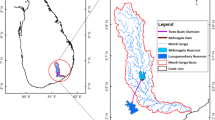Abstract
In 1980, Large dam project “Kaeng Sue Ten” was proceeded under the cabinet-council’s conclusion. It was planned to be located at Song district in Phrae province on the upstream of the Yom River, Thailand. The purposes of this dam are irrigation and flood mitigation. Unfortunately, the troubles had occurred before the dam was built. The inhabitant who suffered from this project and Non-Governmental Organization (NGO) protested the construction of the dam. Until now, Kaeng Sue Ten dam has not been built yet. However, it is necessary to examine the effect of a new dam construction on the Yom River. We evaluated the impact of the Kaeng Sue Ten dam on seasonal water discharge and suspended sediment transport using hydrological simulations of target year 1995 (representative year of the great flood in the Yom River) and 2001 (representative year of the normal flow in the Yom River). Our study area was the main channel of the Yom River in northern Thailand. We used the 1-km distributed flow routing model (1KFRM) to calculate seasonal change of water discharge at four points. Sediment load was calculated from a regression equation between sediment load and water discharge, using suspended sediment concentrations in monthly river samples taken at two gauging stations. Finally we estimated annual sediment load along the study reach using from both of simulated annual hydrograph and the regression equation. Our simulation results show that after construction of dam, there was moderate decrease in peak discharge volume during rainy season (maximum decrease is 21.8%) and corresponding increase in the subsequent season (maximum increase is 40%). The impact of dam construction to the annual maximum discharge in high-water year was significantly larger than in water year 2001, indicating that the Kaeng Sue Ten operation will provide more effect on a high-flow year than a low-flow year. Accordingly, after dam construction, the sediment transportation decreased about 2% to 9.7% from its former value at Y.14 and Y.6 stations.
Similar content being viewed by others
References
Adamson, P. (2001). “The potential impacts of hydropower developments in yunnan on the hydrology of the lower mekong.” International Water Power and Dam Construction, Vol. 53, No. 3, pp. 16–21.
Bai, Y., Wagener, T., and Reed, P. (2009). “A top-down framework for watershed model evaluation and selection under uncertainty.” Environmental Modelling & Software, Vol. 24, No. 8, pp. 901–916.
Baran, E. and Myschowoda, C. (2009). “Dams and fisheries in the mekong basin.” Aquatic Ecosystem Health and Management, Vol. 12, No. 3, pp. 227–234.
Chen, X., Zong, Y., Zhang, E., Xu, J., and Li, S. (2001). “Human impacts on the changjiang-yangtze river basin, china, with special reference to the impacts on the dry season water discharges into the Sea.” Geomorphology, Vol. 41, Nos. 2–3, pp. 111–112.
Collier, M., Webb, R. H., and Schmidt, J. C. (1996). Dams and rivers: Primer on the downstream effects of dams, United States Geological Survey, Circular 1226.
Dai, Z., Chu, A., Stive, M., and Yao, H. (2012). “Impact of the three gorges dam overruled by an extreme climate hazard.” National Hazards Review, Vol. 13, No. 4, pp. 310–316.
Dore, J. and Lebel, L. (2010). “Gaining public acceptance: A critical strategic priority of the world commission on dams.” Water Alternatives, Vol. 3, No. 2, pp. 124–141.
Dudgeon, D. (2005). “River rehabilitation for conservation of freshwater biodiversity in monsoonal Asia.” Ecology and Society, Vol. 10, No. 2, pp. 15: 1–20, [online] URL: http://www.ecologyandsociety.org/vol10/iss2/art15/.
Graf, W. L. (2006). “Downstream hydrologic and geomorphic effects of large dams on american rivers.” Geomorphology, Vol. 79, Nos. 3–4, pp. 336–360.
Joo, J., Kjeldsen, T., Kim H. J., and Lee, H. (2014). “A comparison of two event-based flood models (ReFH-rainfall Runoff Model and HEC-HMS) at two Korean Catchments, Bukil and Jeungpyeong.” Korean Society of Civil Engineers Journal of Civil Engineering, Vol. 18, No. 1, pp. 330–343.
Moriasi, D. N., Amold, J. G., Van Liew, M. W., Bingner, R. L., Harmel, R. D., and Veith, T. L. (2007). “Model evaluation guidelines for systematic quantification of accuracy in watershed simulations.” Transactions of the American Society of Agricultural and Biological Engineers, Vol. 50, No. 3, pp. 885–900.
Tachikawa, Y. (2011). Distributed rainfall-runoff model, Department of Civil and Earth Resource Engineering, Kyoto University.
Tachikawa, Y. and Toan, D. D. (2013). User manual for distributed flow routing model: 1K-FRM Version 1.37, Department of Civil and Earth Resource Engineering, Kyoto University.
Tebakari, T. and Fukami, K. (2005). “Foundational study on water use and flood control effect by the large scale reservoir — A case study in upper chao phraya river basin, Kingdom of Thailand.” Annual Journal of Hydraulic Engineering, Japan Society of Civil Engineers, Vol. 49, No. 1, pp. 457–462.
Williams, G. P. and Wolman, M. G. (1984). Downstream effects of dams on alluvial rivers, United States Geological Survey Professional Paper: 1286.
Yang, S. L., Zhang, J., and Xu, X. J. (2007). “Inuence of the three gorges dam on downstream delivery of sediment and its environmental implications, Yangtze River.” Geophysical Research Letters, Vol. 34, No. 10, DOI: 10.1029/2007gl029472.
Author information
Authors and Affiliations
Corresponding author
Rights and permissions
About this article
Cite this article
Apichitchat, S., Jung, K. Hydrological simulation for impact assessment of Kaeng Sue Ten dam in Thailand. KSCE J Civ Eng 19, 2325–2332 (2015). https://doi.org/10.1007/s12205-015-0322-3
Received:
Revised:
Accepted:
Published:
Issue Date:
DOI: https://doi.org/10.1007/s12205-015-0322-3




